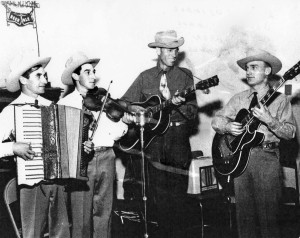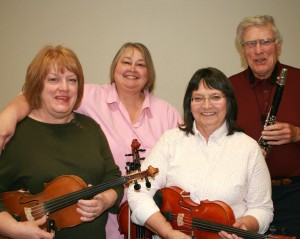By George Sibley
“Employer wanted.” We saw that sign in Missouri, along US 36 – a good “heartland” road: if you laid a ruler on the map with Denver at one end and Indianapolis at the other, you’d see a line already there, US 36. Interstate 80 runs above it, Interstate 70 below, if you want to zip past and avoid it all, but if you want to go through the so-called heartland, US 36 is a good transect. A lot of it is still two-lane blacktop through Kansas, but it’s a fast two-lane with very little traffic, so long as you keep watch for the occasional tractor the size of a dinosaur traveling 17 mph.
US 36 is still Main Street for the smaller towns, a crossroad block or two of seasoned storefronts. The bigger towns usually have a 1950s four-lane bypass to the north or south of the main town, with a business route to the old downtown, often built around a courthouse square with solid two- or three-story brick or stone buildings facing the square. Bigger towns or smaller, though, most of the commercial activity seems to be franchises and chains out along the bypass or on the edge of town: Walmart, NAPA and McDonalds for the bigger towns, Family Dollars and gas-and-go convenience stores for the smaller. Local businesses downtown tend to be “heritage stores” (inherited, can’t afford to leave), antiques-and-collectibles shops or just thrift stores retailing the town’s past, and a Mexican restaurant as well as the Main Street Cafe, reflecting the heritage of today’s hard-labor force.
Between the towns, it still looks like an agricultural region with fields of corn, soybeans, et cetera, stretching away to the horizon. But the diminished towns give away the fact that this region is no longer an “agri-culture” – a culture based around a critical mass of people who farm as a way of life as well as a living, with a community that supports, engages, encourages that. The size of tractors and other equipment at work in the fields is another giveaway. This is an industrial zone practicing agribusiness. The town culture is mostly the same homogenized, industrial culture that comes down through the schools and television everywhere in urban-industrial America, and increasingly the world. And that TV culture selling all seven deadly sins seems today almost as remote from US 36 as it is from Faroffistan in Asia.
“Employer wanted.” Creating jobs was the noise in the America media as we drove east, heading for Wisconsin, my partner’s home state, for which she gets pretty homesick. My pinko liberal Internet news sites indicated that the president and the congressional clown show have finally decided they can no longer avoid the fact that one working-age American in every six is unemployed, underemployed, or hopeless, and they have been kicking jobs plans back and forth, ranging from the plausible to the laughable.
But I get restless when we start talking about jobs as though they were an end in themselves, something that can be mass-produced through the manipulation of the political economy, problem solved. “Employer wanted.” We want to be employed. But doing just anything at all? Any kind of jobs?
An editorial last month in the Denver Post suggested that that is not the case. It was about the need to bring “guest workers” into a nation with high unemployment to fill jobs harvesting the American food supply. The writer cited the example of a farmer in Olathe, over here in the Gunnison Basin, who – in an area that has been chronically depressed – cannot find people to work on the harvest at $10.50 an hour. Historically, this work has been done by Mexicans, documented and undocumented, but that flow of workers has dropped to a trickle due to a weak U.S. economy and hostile environment. The hard physical jobs those “guests” filled are apparently not what people have in mind when they say “Employer wanted.”
Some of the noise as we were traveling to Wisconsin was about a Jobs named Steve, who died in the middle of the jobs debate – a real loss because he created a lot of jobs in his life. But did Steve Jobs ever spend time thinking about creating jobs? I doubt it. He was into ideas, ideas for things, things he thought people would want. And in the process of working out his ideas, jobs seemed to follow in Jobs’ wake, making and selling his ideas. Many, maybe most of those Job’s jobs, went to places where people would work for less money than Americans are willing to work for, but a lot of them located here, too.
Back to Wisconsin. I say my partner Maryo gets homesick for Wisconsin and its unique places. I think she is also somewhat in love with a Wisconsin that has still not quite happened, but still could – a love with which I am also infected. She got to know Wisconsin through summer jobs working for her father, Bob Gard, whose job was to be a “circuit-riding playwright” for – read this twice – the College of Agriculture at the University of Wisconsin.
For the middle third of the 20th century, UW’s College of Agriculture also employed a painter, musicians, a dance instructor, and other artists whose jobs were all similar to Gard’s. That is, to be out in the farming communities of Wisconsin, helping develop the innate skills and ideas of people that in turn would make their communities more vital, resilient and creative. The Ag College had scientists and agronomists to help Wisconsinites become better farmers, but it also strove for a stronger “agriculture” – agrarian culture.
Did it work? Well, the University of Wisconsin – now known mainly for its Saturday afternoon Badgers – no longer has playwrights and painters and dancers on the Ag College faculty. It’s pretty much all about agribusiness today. And local culture in Wisconsin, like local culture in Central Colorado and US 36 and everywhere else, got steamrolled by the urban-industrial juggernaut. It is now pretty much franchised from the mainstream and those chains that bind us all together in a big mass TV culture (although there are still some good bars with restaurants that have fish fries every Friday and only turn up the TV for Packer and Badger games).
So – maybe “Ideas wanted,” some creativity, grassroots energy, would be a better request. We don’t need jobs; we need engaging, exciting ideas, like seeds from which jobs will spring up. And that thought causes my grasshopper mind to jump to Aztalan.
The other day we came across Aztalan State Park in Wisconsin, a prehistoric site. I was intrigued because “Aztlan” is a mythic “place of whiteness and herons” for the Chicano people back home in the Southwest, and in Mexico, the mythic homeland of the Mexican Indians. It turns out that this Aztalan in Wisconsin was the northernmost extension of the “mound-builder” culture, an early American civilization centered near St. Louis, at a place called Cahokia, from which it had spread in all directions. Maybe as far as Mexico? Or did it come up from Mexico? What we know for sure is that there were large agri-cultures a thousand years ago all over North America, from central Mexico to southern Wisconsin, who had three things in common: a common diet of corn, beans, and squash; trading networks that had ocean shells coming to Wisconsin and the high deserts; and the building of big earth mounds or stone pyramids. Call it the United Nations of Corn, Beans and Squash.
What did they do? All we know for sure is that they farmed corn, beans and squash, and built burial mounds and pyramids – most of them with nothing but tools of stone, bone and wood. At Aztalan, the mounds were maybe only 25-30 feet high; they were much larger in Cahokia. And the Mexican pyramids are huge. Why did they do these things? One theory holds that it was a good way to keep farming peoples busy during the off seasons – a system of meal tickets in a socialistic society, for allotments of corn and beans and squash. Jobs, in other words – busy work, as the Republicrats portray each other’s job plans. But I cannot believe that was all it was. To get people to work that hard, there had to be an engaging idea, something to believe in. The mound-builders thrived in North America for around 300 years – we’ve been faltering since 200. It had to be work that had some meaning to them, some idea bigger than themselves to be part of besides a food chain. Not jobs for the sake of jobs. But then – something happened, 800-900 years ago, and everywhere in North America above central Mexico, the United Nations of Corn, Beans and Squash just disappeared. Climate change or cultural change? Did the work they were doing become just jobs?
Meanwhile, back in the present. Imagine now the mounds, the middens – the iPiles – we would leave behind if, sometime in the future, we were to walk away from a depleted culture where jobs are just jobs, access to meal tickets and part of nothing larger than that, no leadership united behind the kind of vision from which meaningful work would sprout like corn from seed.
George Sibley was born in Western Pennsylvania, but was conceived in Colorado by Colorado natives, and thus considers himself to be a native Coloradan.


